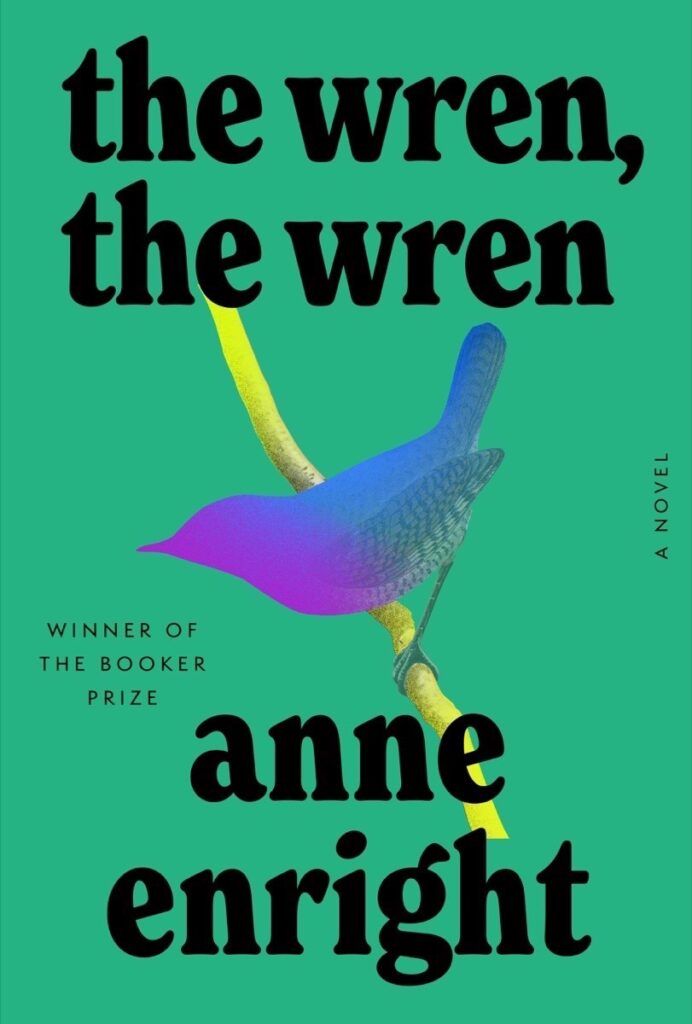Dublin-based writer Anne Enright had a magnificent problem in the early stages of writing her new book The Wren, The Wren: A Novel (W. W. Norton & Company, $27.95). Readers may find her description of this dilemma to be a source of joy.
“Whenever you’re doodling, playing with a scene or situation or character, there comes a moment where you realize you’ve created a character you’re going to commit to. There is a sinking feeling, because you know by the end of the process, you have to like them. Even if they start out as something slightly irritating,” she says, speaking via Zoom conversation from her home in Ireland.
Although Enright is frequently asked about the ideas that generate her story collections and eight novels that include The Green Road, The Forgotten Waltz, and the Booker-winning The Gathering, she declines the invitation to place the crown of creativity on pre-formulated notions.
“You’re working at the beginning of a book not with an idea but with a problem,” she says.
The “problem,” or the tension, Enright encountered in writing The Wren emanated from its central character Carmel, a middle-aged, tough-minded woman whose extreme practicality was in direct conflict with her lyrical world. Writing during the pandemic, surrounded by and struck with wonder at the saturated beauty of nature, Enright found herself filled with a slight dread at the notion of writing Carmel’s story arc. It wasn’t until she realized her protagonist could have a child that the author began to have fun.
“Once [Carmel] had Nell, [Carmel] became a properly tragic figure, because her limitations become onerous to her. She loves her daughter more than anything, but she’s still that implacable person. It’s the problem of love, I suppose. I was suddenly galvanized. All my characters are contradictory. It’s that tension that makes a narrative start to hum along.”
But Carmel, Nell, and other characters don’t just “hum” in The Wren. They holler, whisper, croon, cajole, threaten, tease, express astonishment, ambivalence, and vulnerability, along with love and rage or other emotions common among families.

Readers quickly learn that Carmel’s father is the famed Irish poet Phil McDaragh, who abandons his wife Terry and two-year-old Carmel when Terry is diagnosed with cancer. The book is told in alternating chapters by Carmel speaking in third person; Nell’s untethered 23-year-old first-person voice; and sporadically by Phil through his bird poems, a letter sent to Carmel on her 16th birthday, and a YouTube video she watches years after her father has died. In one chapter, Phil recalls being a 12-year-old boy and describes his lost love for a girl, lost faith in the Catholic Church, and—with a disturbingly equal degree of pathos—the death of a badger.
If this panorama seems sprawling, never fear. Enright is masterful in gathering disparate threads, rendering them sturdy, like ropes used to anchor large ships. The author keeps our attention on the mother-daughter dynamic at the heart of the book, and on each woman’s relationship to self. Carmel is never anxious, until she is. Nell is never realistic about Felim, the abusive man she becomes enamored with, until she is. Phil remains the outlier: opaque, oblique not only to his own self, but to his family and the world at large.
But Enright admits she did wrangle with the book’s center of gravity. Two years into the writing process, she rearranged the story to open with Nell’s voice.
“When she started talking, I was so pleased,” Enright says. “Phil atrophied a little—a father, a poet, and he remained a person who wasn’t really alive in the book, sort of a dead person behind interesting pieces of texts. It is Carmel and Nell and their relationship that are the axis of the book.”
Nell’s doomed, destructive love relationship with Felim is echoed by tales of her grandfather’s romances. For the McDaragh characters, this yearning, this pain caused by the absence of a particular love object—not the absence of a particular person—is a driving force. This connection unifies characters who might never know each other, leaving them inextricably tied.
The book’s emotional range is encapsulated by poems about birds found sprinkled throughout the book’s 278 pages. These odes beg the question, “Who is the author and what is the author’s?”
When the queries are posed to her, Enright says, “I love these questions. These are really exciting to me. I’m not going to answer them! They’re questions I opened, but I don’t resolve them. Back in the day, people would say, ‘Is that you in your book or your family in the book?’ So I would deliver book after book and say, here’s another family, do you think that’s my family? I managed to astonish the prurience of the reader by indifference to it. You want a family? Try this one for size. I’m playing hide-and-hide, not hide-and-seek. I’m not going to be found in these texts, and that’s a lot of fun.”
In contrast to characters from Wren’s other books who she says she allowed to “inhabit” her, is that in The Wren, the character of Phil gets to speak his own voice. The sensibilities of his time and his lack of understanding are permitted, and allow the reader to see him more accurately than he sees himself. At the same time, positioning him as a poet offered to Phil a certain purity, an adopted authority as a member of an exclusive club.
“Poetry has a sacred aura as if it can’t be imitated,” says Enright. “That means the poet is always sincere. So to imitate Phil, who imitates real Irish poets, is exciting because it disturbs those ideas. There is fun on my part too, when you see Phil’s values, self-involvement, self-pity, and self-aggrandizement come through in verse. I didn’t do too much of that. I wanted to stick close to poetic values that would hold.”
Phil translates old Irish poetry and in so doing, speaks through historical, purist poets such as Saint Columba. “I’d be happy translating poetry for a long time. I don’t know why I didn’t take it up as a life’s ambition,” Enright says.
The Wren has several scenes where violence, tenderness, and humor intermingle. There is a fight between Carmel and her sister Imelda, conducted in complete silence. There is the violence of cancer on Terry’s body and the gaping hole left by her husband’s abandonment. Enright says the latter is rupture, as opposed to trauma, a word she believes is overused. The badger scene recalled by Phil is what Enright calls “everyday violence,” perhaps even becoming revered or sacred as it is transmitted in the men of his family’s attitude about the animal’s killer. Again, the ambiguity of connection and violation that co-exist.
“It’s an astonishing world view,” she says, marrying their attitude to Oscar Wilde’s old idea that each man kills the thing he loves. “Phil’s going around bashing his kids on the back of the head when he didn’t like the books pages in the newspaper; that scene is perfectly normal. And if you got in the way of his hitting hand it was your own fault. The mother says he’s just a big baby.”
Enright surprised even herself with the absurd fight scene between the two sisters. “It reads comically, because they’re so bad at it. They’re not effectively hurting each other all that much; they’re just incredibly furious. It’s like when siblings fight when they’re eight or nine—but they’re not eight or nine, they’re 35. That’s what makes it darkly funny.”
The Wren deals in small, domestic, taboo violence. In one instance, its plot breaks Carmel open and causes her to experience a brief psychotic episode. The dark outburst never overwhelms or overshadows the complete dimensionality of love she has for Nell—and the eagerness of both of them to forgive and forget.
“I expect the reader to be on-side with characters and find themselves caught up in the fact that they too do wrong things,” says Enright. “I expect moral pliability, moral shock, or identification.”
She says one of the advantages of writing about families in a culture like Ireland is that people are stuck with each other as opposed to societies that are more transient.
“We look at emigration with nostalgia when actually, a lot of people just ran out of the place due to moral or emotional necessity,” says the author. “[In Ireland] our family connections are a given. You can’t leave them. When [legal] divorce came in the late 1990s, there wasn’t a huge humber of them. We’re more bound than other societies.”
Enright says the bleakest of Irish humor comes from North Ireland, and arose from the region’s many difficulties.
“When I was growing up, humor was the way to sure truth,” she recalls. “And it was black humor.”
Typically unspeakable abuse perpetrated by the Catholic Church could be expressed through jokes. Nobody stopped such quips, although they didn’t cause anyone to prevent what was happening. The jokes simply allowed people—women and children especially—to speak about the tragedy in their midst. And to laugh, in addition to crying.
Fortunately, when asked about future works Enright does not seem to be done with some of the “problems” with which she embued The Wren.
“I do think what I was interested in, in the character of Nell, is gathering thoughts of younger women. The difference and pleasure of submission, how women situate themselves in regards to the online world. Those are fresh and new to me. I like reading young writers because the Irish women in particular are more confident. A gap is closing, so they’re saying things that haven’t been articulated before. In my generation, there was certainly an urgency about what had to be said. But [young writers] are figuring things out on the page. I love to see it. My own writing—publication has been quite intense, so I’m highly scheduled. I am on the inhale in that regard. Something will trickle out. There’s a tide in creative matters. It’s not ideas you need, it’s a rising interest.”
Purchase The Wren, the Wren: A Novel here.






